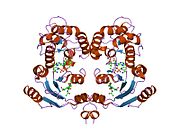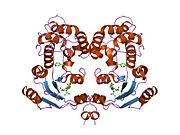BST1
Ensembl | |||||||||
|---|---|---|---|---|---|---|---|---|---|
| UniProt | |||||||||
| RefSeq (mRNA) | |||||||||
| RefSeq (protein) | |||||||||
| Location (UCSC) | Chr 4: 15.7 – 15.74 Mb | Chr 5: 43.98 – 44 Mb | |||||||
| PubMed search | [3] | [4] | |||||||
| View/Edit Human | View/Edit Mouse |
Bst1 (Bone marrow stromal cell antigen 1, ADP-ribosyl cyclase 2, CD157) is an enzyme that in humans is encoded by the BST1 gene.[5][6][7] CD157 is a paralog of CD38, both of which are located on chromosome 4 (4p15) in humans.[8]
Bst1 is a stromal cell line-derived glycosylphosphatidylinositol-anchored molecule that facilitates pre-B-cell growth. The deduced amino acid sequence exhibits 33% similarity with CD38. BST1 expression is enhanced in bone marrow stromal cell lines derived from patients with rheumatoid arthritis. The polyclonal B-cell abnormalities in rheumatoid arthritis may be, at least in part, attributed to BST1 overexpression in the stromal cell population.[7]
CD157 and CD38 are both members of the ADP-ribosyl cyclase family of enzymes that catalyze the formation of nicotinamide and adenosine diphosphate ribose (ADPR) or cyclic ADP-ribose (cADPR) from NAD+, although CD157 is a much weaker catalyst than CD38.[9][10][11] cADPR is required for regulation of Ca2+ in cells.[10] Only CD38 hydrolyzed cADPR to ADPR.[11] CD38 is widely expressed in tissues, whereas CD157 is primarily found in gut and lymphoid tissue.[11]
CD157 has an important role in controlling the migration of
CD157 contributes to macrophage killing of the Mycobacterium tuberculosis bacteria responsible for tuberculosis.[12]
CD157 is highly expressed in acute myeloid leukemia, and is being evaluated as a diagnostic sign, as a treatment target, and as a means of monitoring treatment progress.[13]
BST1 and
See also
References
- ^ a b c GRCh38: Ensembl release 89: ENSG00000109743 – Ensembl, May 2017
- ^ a b c GRCm38: Ensembl release 89: ENSMUSG00000029082 – Ensembl, May 2017
- ^ "Human PubMed Reference:". National Center for Biotechnology Information, U.S. National Library of Medicine.
- ^ "Mouse PubMed Reference:". National Center for Biotechnology Information, U.S. National Library of Medicine.
- PMID 29162908.
- PMID 8202488.
- ^ a b "Entrez Gene: BST1 bone marrow stromal cell antigen 1".
- ^ S2CID 205732787.
- PMID 31881755.
- ^ PMID 18626062.
- ^ PMID 29514064.
- PMID 31963337.
- PMID 31817547.
- PMID 28515364.
External links
- Human BST1 genome location and BST1 gene details page in the UCSC Genome Browser.
- Overview of all the structural information available in the PDB for UniProt: Q10588 (Human ADP-ribosyl cyclase/cyclic ADP-ribose hydrolase 2) at the PDBe-KB.
Further reading
- Ortolan E, Vacca P, Capobianco A, et al. (2003). "CD157, the Janus of CD38 but with a unique personality". Cell Biochem. Funct. 20 (4): 309–22. S2CID 23453325.
- Lee BO, Ishihara K, Denno K, et al. (1996). "Elevated levels of the soluble form of bone marrow stromal cell antigen 1 in the sera of patients with severe rheumatoid arthritis". Arthritis Rheum. 39 (4): 629–37. PMID 8630113.
- Kajimoto Y, Miyagawa J, Ishihara K, et al. (1996). "Pancreatic islet cells express BST-1, a CD38-like surface molecule having ADP-ribosyl cyclase activity". Biochem. Biophys. Res. Commun. 219 (3): 941–6. PMID 8645283.
- Okuyama Y, Ishihara K, Kimura N, et al. (1997). "Human BST-1 expressed on myeloid cells functions as a receptor molecule". Biochem. Biophys. Res. Commun. 228 (3): 838–45. PMID 8941363.
- Muraoka O, Tanaka H, Itoh M, et al. (1997). "Genomic structure of human BST-1". Immunol. Lett. 54 (1): 1–4. PMID 9030974.
- Wimazal F, Ghannadan M, Müller MR, et al. (2000). "Expression of homing receptors and related molecules on human mast cells and basophils: a comparative analysis using multi-color flow cytometry and toluidine blue/immunofluorescence staining techniques". Tissue Antigens. 54 (5): 499–507. PMID 10599889.
- Yamamoto-Katayama S, Sato A, Ariyoshi M, et al. (2001). "Site-directed removal of N-glycosylation sites in BST-1/CD157: effects on molecular and functional heterogeneity". Biochem. J. 357 (Pt 2): 385–92. PMID 11439087.
- Liang F, Qi RZ, Chang CF (2001). "Signalling of GPI-anchored CD157 via focal adhesion kinase in MCA102 fibroblasts". FEBS Lett. 506 (3): 207–10. S2CID 34408861.
- Yamamoto-Katayama S, Ariyoshi M, Ishihara K, et al. (2002). "Crystallographic studies on human BST-1/CD157 with ADP-ribosyl cyclase and NAD glycohydrolase activities". J. Mol. Biol. 316 (3): 711–23. PMID 11866528.
- Strausberg RL, Feingold EA, Grouse LH, et al. (2003). "Generation and initial analysis of more than 15,000 full-length human and mouse cDNA sequences". Proc. Natl. Acad. Sci. U.S.A. 99 (26): 16899–903. PMID 12477932.
- Funaro A, Ortolan E, Ferranti B, et al. (2005). "CD157 is an important mediator of neutrophil adhesion and migration". Blood. 104 (13): 4269–78. S2CID 12053010.
- Gerhard DS, Wagner L, Feingold EA, et al. (2004). "The status, quality, and expansion of the NIH full-length cDNA project: the Mammalian Gene Collection (MGC)". Genome Res. 14 (10B): 2121–7. PMID 15489334.
- Hillier LW, Graves TA, Fulton RS, et al. (2005). "Generation and annotation of the DNA sequences of human chromosomes 2 and 4". Nature. 434 (7034): 724–31. PMID 15815621.
- Liu T, Qian WJ, Gritsenko MA, et al. (2006). "Human plasma N-glycoproteome analysis by immunoaffinity subtraction, hydrazide chemistry, and mass spectrometry". J. Proteome Res. 4 (6): 2070–80. PMID 16335952.
This article incorporates text from the United States National Library of Medicine, which is in the public domain.






